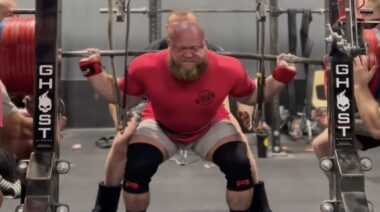Tempo training is common for upper body and core movements, but is often neglected for lower body exercises. Why should you use tempo training for your legs? It all starts with the hips. The perfect squat is about as rare as the perfect running stride. About 90% of the time, any athlete who comes to me for training has dysfunctional hips. Damn you, chairs!
Tempo training is common for upper body and core movements, but is often neglected for lower body exercises. Why should you use tempo training for your legs? It all starts with the hips. The perfect squat is about as rare as the perfect running stride. About 90% of the time, any athlete who comes to me for training has dysfunctional hips. Damn you, chairs!
Think about how many hours per day you sit in a chair. For the average American, it’s about 13 hours.1Sitting creates a myriad of problems from our ankles to our necks, but it devastates our hips and lower backs.
It shortens your hip flexors and hamstrings, which throws your hip function out of whack. There are so many moving pieces, from the piriformis to the iliopsoas group, that need to fire correctly in order to squat well.
If even one of these muscles is tight, not firing, or atrophied, all of the rest of the muscles involved in the hip will be affected by overcompensating and taking on additional stress. That creates a snowball effect, which can spiral out of control if not properly addressed.
The Tempo Training Solution
The solution to hip dysfunction is not to rush through exercises and add in explosive movements. We must take an approach that will correct the muscular imbalances and teach these muscles to fire correctly once more.
We can use tempo leg training to fix these imbalances while continuing to build your muscular endurance and stability. For those unfamiliar with this style of training, you are simply performing longer, more controlled repetitions of any given exercise.
A lift has three main phases:
- Eccentric – the lengthening or loading phase
- Isometric – the static or holding phase
- Concentric – contraction or shortening phase
Each phase of the lift can be manipulated, or we can program a tempo for all three phases. The tempos of these repetitions can vary depending on the goal. Some examples of time under tension tempos may look like this:
- 5:5:5 – In this example, we are taking five seconds in each of the above phases to draw out the movement and increase our muscular endurance.
- 5:3:1 – This tempo slows down the eccentric portion of the lift to create a demanding load phase, but emphasizes an explosion out of the isometric phase to create a quick concentric lift.
- 1:5:1 – Here we focus on the isometric phase and really contract the muscles during the hold at the bottom of the lift to create stability.
Tempo Training Exposes Malfunction
Even if you are one of the very few who don’t suffer from muscular imbalances and dysfunctions, tempo training can still be useful for you.
Tempos allow you to feel exactly where your technique falters in lower body movements. There is no such thing as too good when it comes to technique, especially if you want to stay injury-free.
The easiest way to accomplish all these tasks is with extremely long time-under tension repetitions. This tempo is going to be very slow and challenging, so leave your ego at the door.
For each movement, start with only bodyweight. That means only your body, no bar, no weights, nothing additional. You can always add weight after you feel comfortable with just your body.
These movements will address all of your sticking points and help you pinpoint exactly which muscles are imbalanced and where in the movement your dysfunctions are limiting you.
Having trouble getting out of the hole? You will be able to feel even the slightest lifting of your butt and arching of your back when coming out of the bottom of the squat. Is your ankle dorsiflexion a problem?
With this technique you will feel exactly where and when your mobility begins limits you within a lower body lift. Is there a certain depth where your knee collapses inward during the lunge? You get the point.
Incorporate long tempo repetitions to get rid of your muscular imbalances. [Photo credit: J Perez Imagery]
Tempo Training Corrects Your Malfunction
There are three major lifts that I use to correct all of these lower body malfunctions:
- The squat
- The reverse lunge
- The deadlift
For each movement, take 20 seconds to perform the eccentric phase, pause for 20 seconds to hold and contract your muscles during the isometric phase, and take 20 seconds to slowly ascend during the concentric phase.
These are extremely long repetitions lasting a minute each. You want to start with long tempo repetitions to really slow down the movement and feel exactly when and where you have problems.
When you perform these long reps, you should pace each phase evenly. For example, in the squat, in the eccentric phase your legs should be about parallel after 10 seconds; the other 10 seconds are used to slowly get into the full-depth squat.
During the isometric phase, you should be in a full squat, holding and constantly forcefully contracting your quads, glutes, and various hip muscles.
The concentric phase should be the eccentric in reverse. At the 10-second point you should be close to parallel, and the final 10 seconds of your ascent will lead you to the standing position.
Even with the deadlift, you will perform the movement with no weight and very slowly at first. The purpose of these exercises is to focus on your technique, so you should still pretend you’re holding a bar.
Don’t let your arms flop all over the place. Your muscles should be engaged throughout this entire slow movement. In the deadlift, you will still have proper form with your shoulders slightly back, neutral spine, and ankles in a slight dorsiflexion.
During each movement, you want to fine-tune your body awareness. Close your eyes. Feel where your discomfort and tightness are. Feel which muscles get fatigued quickly during contraction. Feel where your weight is distributed and if one side is taking on too much of the load.
Feel free to switch up the variations of these movements. If you’re an Olympic lifter, start out in the overhead squat. If you are a frequent CrossFit competitor, you may want to use the front squat.
Maybe you prefer the trap bar deadlift. Same thing, have your arms as you normally would by your sides, instead of in front of you. Just remember to always start with your bodyweight.
All athletes should practice maximum squat depth and a full range of motion in each movement to utilize their full mobility. Not accustomed to a full-depth squat?
Hold on to a support at first while performing the movement until you get your bearings and mobility squared away.
Put It to Use
This is a great training method to create additional stress on the lower body muscles which can often be neglected. With these long repetitions, you will certainly overload the muscle past its current capacity. Mix this technique with explosive movements to maximize your lower body training.
These techniques will benefit every athlete. Given the hip health of the average American, they are techniques that everyone needs. Incorporate long tempo repetitions to get rid of your muscular imbalances, dysfunctions, and to hone your technique.
More on form and function:
How to Fix a Good-Morning Style Squat
Coaches, help you athletes move better:
The 4 Phases of a Solid Strength Program
Reference:
1. Ergotron. “New Survey: To Sit or Stand? Almost 70% of Full Time American Workers Hate Sitting, but They Do It All Day Every Day.” New Survey: To Sit or Stand? Almost 70% of Full Time American Workers Hate Sitting, but They Do It. Ergotron, 17 July 2013. Web. 04 Oct. 2016.






